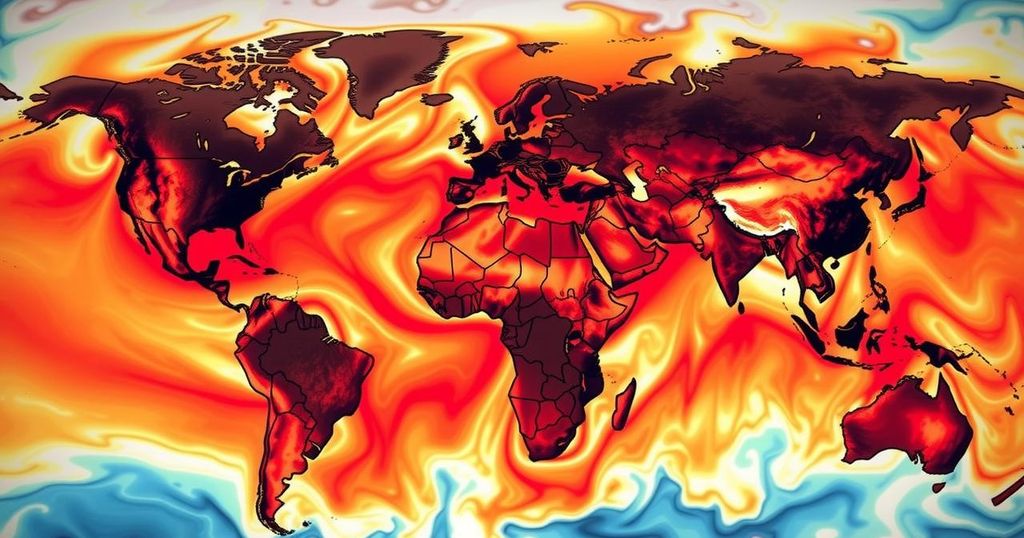Global Warming Surpasses 1.5C Threshold in 2024, Igniting Climate Alarm

In 2024, Earth’s annual temperature surpassed 1.5C, the first time recorded, according to major climate science bodies, indicating a failure to meet the Paris Agreement targets. Contributing factors include greenhouse gas emissions and El Niño conditions, amplifying extreme weather events and global disasters. The scientific community is investigating the causes behind this acceleration in warming, highlighting a decline in atmospheric sulfur aerosols and reduced cloud cover as potential culprits. This unprecedented level of warming necessitates urgent global climate action.
In 2024, global temperatures have exceeded the critical threshold of 1.5C above pre-industrial levels for the first time annually, marking the gravest indication yet that nations are not fulfilling their commitments under the Paris Agreement to limit global warming. This alarming trend has been confirmed by two key climate science bodies, the Copernicus Climate Service and the UK Met Office, which reported a global average temperature of 1.6C and 1.53C above pre-industrial averages, respectively. This increase is being exacerbated by the El Niño phenomenon, alongside long-standing greenhouse gas emissions, contributing to a myriad of climate-related disasters worldwide.
The record heat has been correlated with extreme weather events, including the deadliest day recorded in July 2024, catalyzed by climate change influences, leading to significant loss of life and property. The scientific community is perplexed by the speed at which temperatures have ascended, unable to pinpoint specific reasons for this acceleration. Experts are divided on whether this anomaly represents a temporary spike or if it signals a more enduring warming trend, requiring further research to understand its long-term implications.
Historically, a similar paradox occurred from 1998 to 2013 when global temperatures appeared to plateau, which was later attributed to natural climate variability and gaps in data. With current measurements indicating accelerated warming, experts are more equipped to identify factors that may be contributing to this trend.
Experts cite a decline in atmospheric sulfur aerosols, which traditionally trap heat and can result in higher global temperatures. Furthermore, reduced sulfur emissions from environmental regulations appear to have inadvertently intensified warming by decreasing cloud cover, which normally serves to reflect solar radiation. Observations indicate that lower cloud coverage has coincided with record low albedo, enhancing heat absorption by the Earth’s surface—a concerning revelation underscoring the need for a reevaluation of climate mitigation strategies.
Although breaching the 1.5C limit is historically significant—a milestone discerned only after sustained periods of temperature rise—scientists emphasize the urgent need for comprehensive action to reverse current trends and avert catastrophic climate consequences. The risk that recent changes may constitute a long-lasting shift necessitates a concerted global response to combat climate change effectively.
The topic of climate change remains a pressing global concern, as validated by the recent data showing unprecedented annual temperature increases. The Paris Agreement aims to cap global warming at 1.5C to prevent severe environmental repercussions. Recent findings suggest that various environmental mechanisms, particularly the interplay of natural phenomena like El Niño with human-induced greenhouse gas emissions, are contributing to accelerating temperature rises, exacerbating climate impacts across the planet.
In summary, the year 2024 marks a critical juncture in the climate crisis, as global temperatures surpass the 1.5C threshold for the first time on an annual basis. This development underscores the urgent need for ideal climate action and mitigation strategies to address ongoing warming and its associated effects. The complexities surrounding temperature increases and environmental variables demand a thorough examination and comprehensive efforts from global leaders to meet international climate commitments.
Original Source: www.insurancejournal.com






